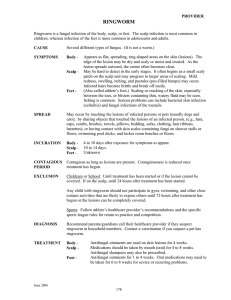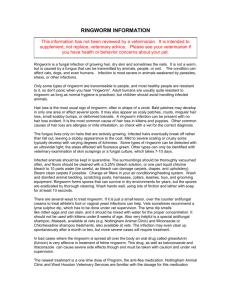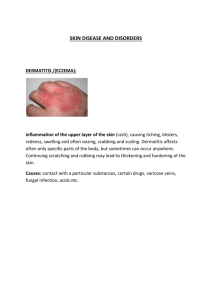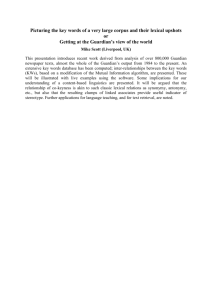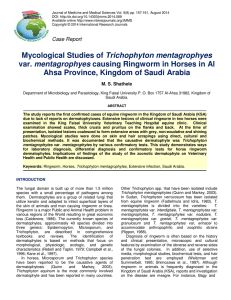Ringworm – A fungal infection that may affect the body, feet, or scalp
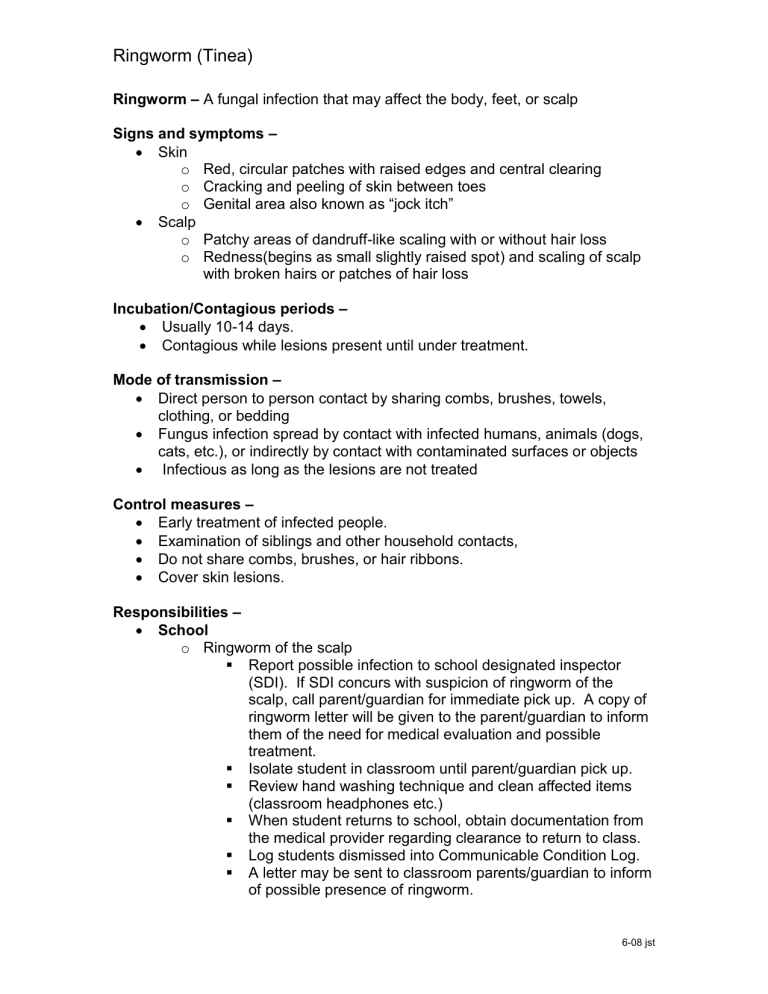
Ringworm (Tinea)
Ringworm
–
A fungal infection that may affect the body, feet, or scalp
Signs and symptoms –
Skin o Red, circular patches with raised edges and central clearing o Cracking and peeling of skin between toes o Genital area also known as “jock itch”
Scalp o Patchy areas of dandruff-like scaling with or without hair loss o Redness(begins as small slightly raised spot) and scaling of scalp with broken hairs or patches of hair loss
Incubation/Contagious periods –
Usually 10-14 days.
Contagious while lesions present until under treatment.
Mode of transmission
–
Direct person to person contact by sharing combs, brushes, towels, clothing, or bedding
Fungus infection spread by contact with infected humans, animals (dogs, cats, etc.), or indirectly by contact with contaminated surfaces or objects
Infectious as long as the lesions are not treated
Control measures –
Early treatment of infected people.
Examination of siblings and other household contacts,
Do not share combs, brushes, or hair ribbons.
Cover skin lesions.
Responsibilities –
School o Ringworm of the scalp
Report possible infection to school designated inspector
(SDI). If SDI concurs with suspicion of ringworm of the scalp, call parent/guardian for immediate pick up. A copy of ringworm letter will be given to the parent/guardian to inform them of the need for medical evaluation and possible treatment.
Isolate student in classroom until parent/guardian pick up.
Review hand washing technique and clean affected items
(classroom headphones etc.)
When student returns to school, obtain documentation from the medical provider regarding clearance to return to class.
Log students dismissed into Communicable Condition Log.
A letter may be sent to classroom parents/guardian to inform of possible presence of ringworm.
6-08 jst
Ringworm (Tinea)
o Ringworm of the body
Report possible infection to SDI. If SDI concurs with suspicion of ringworm, send ringworm letter to parent/guardian informing them of needed treatment.
Does not need to be excluded from school if lesion is covered.
Review hand washing technique and clean affected items.
Upon return to school next day, obtain note from parent/guardian regarding treatment implemented (if no note brought in refer to school nurse).
Log students in Communicable Condition Log.
May send ringworm letter to classroom parents/guardians.
Parent/Guardian o Ringworm of the scalp
Pick up child immediately and seek necessary medical evaluation.
Secure documentation from the medical provider regarding treatment plan and return to school clearance.
Complete course of medication if indicated providing school with medication consent form if treatment required during school hours.
Nurse o Education of school personnel, parent/guardian, and student about ringworm, including its mode of transmission and means of prevention. o Review Communicable Condition Log weekly providing follow up as indicated or requested.
6-08 jst
